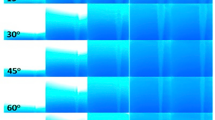Abstract
Leakage of CO2 through fractures in saline formations will increase the CO2—brine interface and promote CO2 dissolution. We use a 2D, finite difference MATLAB model to simulate dissolution rates from a vertical fracture, with CO2 flowing through it, in a secondary storage formation. The instigation of convection currents increases dissolution rates leading to higher dissolution in higher Rayleigh number systems. Comparison of our results with fracture flow rates shows that for typical fracture apertures dissolution from a fracture is small relative to the amount of CO2 flowing through the fracture. Temporal and spatial variations in fracture permeability may reduce fracture flow rates and increase the relative amount of CO2 dissolved from the fracture compared to the CO2 flowing through the fracture. Further work on CO2 dissolution in relation to fracture heterogeneity, flow of CO2 within fractures and the interaction of multiple fractures will improve our ability to predict CO2 dissolution rates for site characterisation.
Similar content being viewed by others
References
Annunziatellis A., Beaubien S., Bigi S., Ciotoli G., Coltella M., Lombardi S.: Gas migration along fault systems and through the vadose zone in the Latera caldera (central Italy): implications for CO2 geological storage. Int. J. Greenh. Gas Control 2(3), 353–372 (2008). doi:10.1016/j.ijggc.2008.02.003
Caine J.S., Evans J.P., Forster C.B.: Fault zone architecture and permeability structure. Geology 24(11), 1025–1028 (1996). doi:10.1130/0091-7613(1996)024<1025
Carneiro J.F.: Numerical simulations on the influence of matrix diffusion to carbon sequestration in double porosity fissured aquifers. Int. J. Greenh. Gas Control 3(4), 431–443 (2009). doi:10.1016/j.ijggc.2009.02.006
Carslaw H., Jaeger J.: Conduction of Heat in Solids, vol. 1, 2nd edn. Clarendon Press, Oxford (1959)
Chalbaud C., Robin M., Lombard J., Martin F., Egermann P., Bertin H.: Interfacial tension measurements and wettability evaluation for geological CO2 storage. Adv. Water Resour. Res. 32(1), 98–109 (2009). doi:10.1016/j.advwatres.2008.10.012
Chang K.W., Minkoff S.E., Bryant S.L.: Simplified Model for CO2 Leakage and its Attenuation due to Geological Structures. Energy Procedia 1(1), 3453–3460 (2009). doi:10.1016/j.egypro.2009.02.136
Ennis-King J., Preston I., Paterson L.: Onset of convection in anisotropic porous media subject to a rapid change in boundary conditions. Phys. Fluids 17(8), 084107 (2005). doi:10.1063/1.2033911
Farajzadeh R., Ranganathan P., Zitha P., Bruining J.: The effect of heterogeneity on the character of density-driven natural convection of CO2 overlying a brine layer. Adv. Water Resour. Res. 34(3), 327–339 (2011). doi:10.1016/j.advwatres.2010.12.012
Farajzadeh R., Salimi H., Zitha P., Bruining H.: Numerical simulation of density-driven natural convection in porous media with application for CO2 injection projects. Int. J. Heat Mass Transf. 50(25-26), 5054–5064 (2007). doi:10.1016/j.ijheatmasstransfer.2007.08.019
Hassanzadeh H., Pooladi-darvish M., Keith D.W.: Scaling behavior of convective mixing with application to geological storage of CO2. AIChE J. 53(5), 1121–1131 (2007). doi:10.1002/aic
Horton, C.W., Rogers, F.T.: Convection Currents in a Porous Medium. J. of Appl. Phys. 16 (1945)
Iding M., Blunt M.J.: Enhanced solubility trapping of CO2 in fractured reservoirs. Energy Procedia 4, 4961–4968 (2011). doi:10.1016/j.egypro.2011.02.466
Iding M., Ringrose P.: Evaluating the impact of fractures on the performance of the In Salah CO2 storage site. Int. J. Greenh. Gas Control 4(2), 242–248 (2010). doi:10.1016/j.ijggc.2009.10.016
Kneafsey T.J., Pruess K.: Laboratory flow experiments for visualizing carbon dioxide-induced, density-driven brine convection. Transp. Porous Media 82(1), 123–139 (2010). doi:10.1007/s11242-009-9482-2
Mathias S., Butler A., Zhan H.: Approximate solutions for forchheimer flow to a well. J. Hydraul. Eng. 134, 1318 (2008)
Mathias S., Hardisty P., Trudell M., Zimmerman R.: Approximate solutions for pressure buildup during CO2 injection in brine aquifers. Transp. Porous Media 79(2), 265–284 (2009)
Neufeld J.A., Hesse M.A., Riaz A., Hallworth M.A., Tchelepi H.A., Huppert H.E.: Convective dissolution of carbon dioxide in saline aquifers. Geophys. Res. Lett. 37(22), 2–6 (2010). doi:10.1029/2010GL044728
Pacala S., Socolow R.: Stabilization wedges: solving the climate problem for the next 50 years with current technologies. Science 305(5686), 968–972 (2004). doi:10.1126/science.1100103
Pruess K.: On CO2 fluid flow and heat transfer behavior in the subsurface, following leakage from a geologic storage reservoir. Environ. Geol. 54(8), 1677–1686 (2007). doi:10.1007/s00254-007-0945-x
Riaz A., Hesse M., Tchelepi H.A., Orr F.M.: Onset of convection in a gravitationally unstable diffusive boundary layer in porous media. J. Fluid Mech. 548, 87–111 (2006). doi:10.1017/S0022112005007494
Sibson R.H.:: Conditions for fault-valve behaviour. Geological Society, London, Special Publications 54(1), 15–28 (1990). doi:10.1144/GSL.SP.1990.054.01.02
Turcotte D., Schubert G.: Geodynamics. Cambridge University Press, Cambridge (2002)
van Reeuwijk M., Mathias S., Simmons C., Ward J.: Insights from a pseudospectral approach to the elder problem. Water Resour. Res. 45(4), W04416 (2009). doi:10.1029/2008WR007421
Xu X., Chen S., Zhang D.: Convective stability analysis of the long-term storage of carbon dioxide in deep saline aquifers. Adv. in Water Resour. Res. 29(3), 397–407 (2006). doi:10.1016/j.advwatres.2005.05.008
Zimmerman R.W., Bodvarsson G.S.: Hydraulic conductivity of rock fractures. Transp. in Porous Media 23, 1–30 (1996)
Author information
Authors and Affiliations
Corresponding author
Rights and permissions
About this article
Cite this article
Watson, F.E., Mathias, S.A., van Hunen, J. et al. Dissolution of CO2 From Leaking Fractures in Saline Formations. Transp Porous Med 94, 729–745 (2012). https://doi.org/10.1007/s11242-012-0021-1
Received:
Accepted:
Published:
Issue Date:
DOI: https://doi.org/10.1007/s11242-012-0021-1




